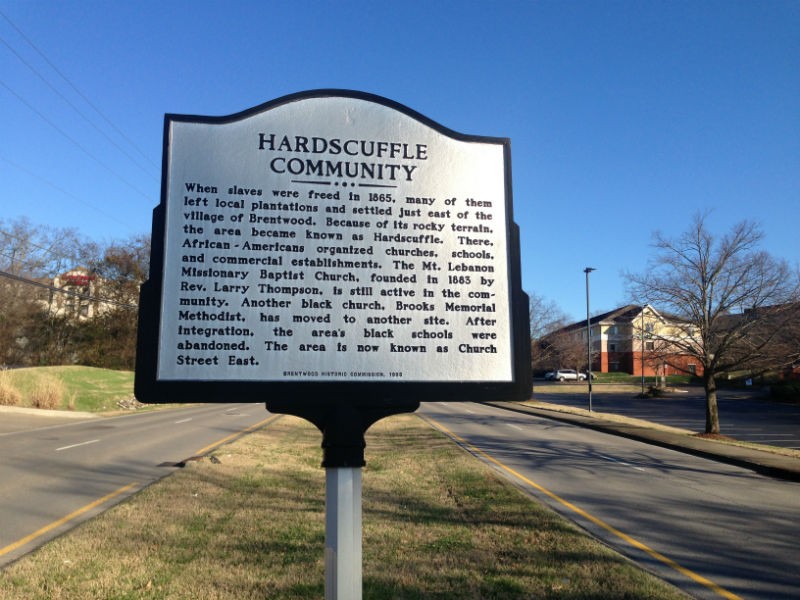The Hardscuffle Community (what is now East Church Street running from Wilson Pike Circle to Edmonson Pike in Brentwood) began after the Civil War when freed slaves were allowed to purchase land. They bought property along Hardscuffle Road, Frierson Street, Wilson Pike, and Franklin Road.
Ex-Slaves Build a Life Along Hardscuffle Road
According to John M. Oden, Jr., in his book The Brentwood I Remember, “It has been reported that wealthy land owners gave the property to those who had been their slaves…[but research shows] that most of the property was bought and paid for by the hard-working families who lived there.”
Being on the border between Davidson and Williamson Counties, neither county provided them with services, so the people of the area grew close and worked together to build their community. There was no electricity or running water. The land was rough and rocky, dusty and unpaved. As a matter of fact, the road got its name from it being a ‘hard scuffle’ to travel on, according to Odom.
Like early settlers anywhere, this hardy collection of about 50 families built schools, churches, a baseball field, and one enterprising gentleman ran a scandalous nightclub. But most of all they hoped to build a life and work to give their families something better as free landowners.
Education of Their Children’s Minds and Souls
There were several schools serving the area, but the Rosenwald School had a most interesting beginning. It was this “two room school” that most of the Hardscuffle Road children attended. The money for the school was provided by the Rosenwald Foundation.
Julius Rosenwald was one of the first investors in the Sears Robuck and Company. Once the catalogue took off, he used some of the funds from his profits to begin building schools for African American communities all over the country. The Hardscuffle school was one of 5,000 he built between 1912 to 1922.
Hardscuffle Road families felt that feeding their children’s minds was important for their future success, but feeding their souls was even more important. Although there were three churches, Mount Lebanon Missionary Baptist Church, Brooks Memorial Methodist Church, and First (Primitive) Baptist Church,the Reverend Elder Owens notes in an article on Livability.com that residents would visit each other’s churches.
Booze and Gambling in 20s to 40s
Not too far from the schools and churches stood the Tumble Down Shack, a nightclub where the booze flowed and money changed hands. In spite of both liquor and gambling being illegal, in Brentwood there was no fear of the law. Many Nashvillians would hit the clubs in Brentwood knowing that there would be no fear of arrest.
Tumble Down Shack was owned by Jim and Sadie Rains. He was quite flamboyant, driving around town in a red and black Stutz Bearcat in his white hat and white shirt with black armbands. The story is told that in 1949, he was rolling the dice for a six when he dropped dead. Guess he got snake eyes instead. It was the beginning of the end of an era.
Martha Marr First Woman Developer
In 1913, Martha Marr was deeded 30 acres from her mother Sara E. Dodson. Seeing opportunity in Brentwood, she turned the land into ten lots for a subdivision. She apparently saw Brentwood as a place for families. Oden notes in his book that it was purchased mainly by African American families. It stood between what is now the Brentwood Suites Hotel and Mallory Station Storage.
A second subdivision was also created in the Hardscuffle Community. It was created by Randal and Rachel Harper. Not until after Randal’s death did the property take off. Leed’s Grocery Store sat on the corner across from the development.
I-65 Changes Everything
With the coming of I-65, the community changed. The original Village of Brentwood was pretty much wiped out by the highway. It also raised property values. The land originally sold for $35 to $50 per lot to former slaves, was worth about $200 during Martha Marr’s time, and in the late 1960s it was suddenly worth $150,000. This price tag allowed these families to find a way to break away from their meager existence. Because homes were available in Nashville for $15,000, and a car for $5,000, reports Williamson Herald, almost all of the families left Hardscuffle Road in the early 1960s, and by the mid-1970s, only one family remained. And they are still there today.
History Lives On
The Hardscuffle Reunion is an event that keeps the history of the area alive. Every five years, in June, families with ties to the community come together for games, a picnic, and sharing. Over 200 people celebrate their history at this event, coming from all over the country, to make sure we never forget the strength and community pride shared by former slaves who did, in fact, build a better life for their families.
Please join our FREE Newsletter



















